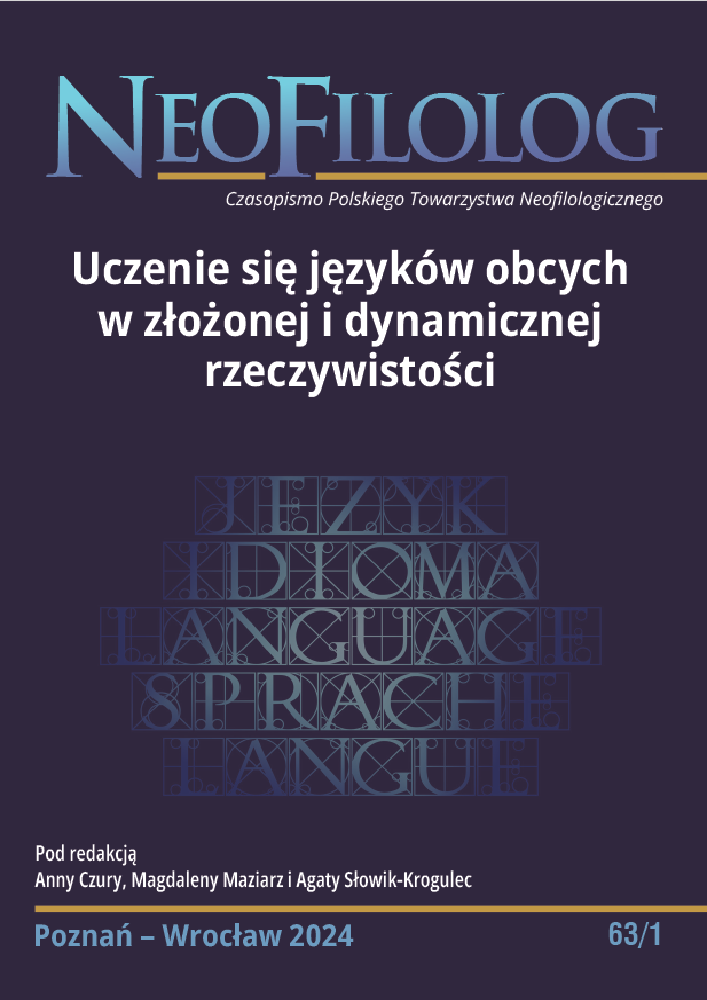Abstract
Over the past decades, the understanding of motivation has undergone significant transformations. Departing from its perception as a stable variable (Gardner, 1985), it has evolved into a nonlinear concept with varying degrees of intensity. Motivation is now recognized as one of many complex dynamic systems (Larsen-Freeman, 2016) characterized by nonlinearity, chaos, unpredictability, sensitivity to initial conditions, openness, self-organization, and responsiveness to feedback and adaptation (Larsen-Freeman, 1997: 142). This article aligns itself with this context and presents an understanding of motivation that assumes nonlinearity, variability, and dynamism. Results of a study involving the observation of the phenomenon of motivation variability under the influence of a pedagogical intervention are presented. The theoretical framework for the conducted research is the L2 Motivational Self-system proposed by Zoltan Dörnyei.
References
Chomsky N. (1986), Knowledge of language: Ist orgin, nature and use. Westport: Greenwood.
Csizér K. (2017), Motivation in the L2 classroom, (w:) Loewen S., Sato M. (red.), The Routledge handbook of instructed second language acquisition. New York – London: Routledge, s. 418–432. DOI: https://doi.org/10.4324/9781315676968-23
Deci E.L., Ryan R.M. (1985), Intrinsic Motivation and Self-Determination in Human Behavior. Nowy Jork: Plenum. DOI: https://doi.org/10.1007/978-1-4899-2271-7
Dewey J. (1938/1963), Experience and education. New York: Macmillan Company.
Dörnyei Z., Csizér K., (1998), Ten commandments for motivating language learners: Results of an empirical study. „Language Teaching Research”, nr 43/1, s. 1–15.
Dörnyei Z., Ottó I. (1998), Motivation in action: A process model of L2 motivation. „Working Papers in Applied Linguistics“, nr 4, s. 43–69.
Dörnyei Z. (2001), Motivational strategies in the language classroom. Cambridge: Cambridge University Press. DOI: https://doi.org/10.1017/CBO9780511667343
Dörnyei Z. (2009), The L2 Motivational Self System, (w:) Dörnyei Z., Ushoida, E. (red.), Motivation, Language, Identity and the L2 Self. Bristol: Multilingual Matters, s. 9–42. DOI: https://doi.org/10.21832/9781847691293-003
Dörnyei Z., Csizer K., Nemeth N. (2006), Motivation, Language Attitudes and Globalisation: A Hungarian Perspective. Clevedon: Multilingual Matters. DOI: https://doi.org/10.21832/9781853598876
Dörnyei Z., MacIntyre P., Henry A. (2015), Motivational dynamics in language learning. Bristol: Multilingual Matters. DOI: https://doi.org/10.4324/9781315772714
Frijda N. (1986), The emotions. Cambridge: Cambridge University Press.
Gardner R.C., Lambert W.E. (1972), Attitudes and Motivation in Second Language Learning. Rowley, MA: Newbury House Publishers.
Gardner R.C. (1985), Social Psychology and Language Learning: The Role of Attitude and Motivation. London: Edward Arnold.
Gould D., Damarjian N., Greenleaf C. (2002), Imagery training for peak Performance, (w:) Van Raalte J.L., Brewer B.W. (red.), Exploring Sport and Exercise Psychology. Washington, DC: American Psychological, s. 55–82. DOI: https://doi.org/10.1037/14251-004
Hotho S. (2000), “Same” or “different”? A comparative examination of classroom factors in second language settings. „Foreign Language Annals”, nr 33, s. 320–329. DOI: https://doi.org/10.1111/j.1944-9720.2000.tb00609.x
Kozielecki J. (1981), Psychologiczna teoria samowiedzy. Warszawa: PWN.
Larsen-Freeman D. (2016), Classroom-oriented research from a complex systems perspective. „Studies in Second Language Learning and Teaching”, nr 6 (3), s. 377–393. DOI: https://doi.org/10.14746/ssllt.2016.6.3.2
Larsen-Freeman, D. (1997), Chaos/complexity science and second language acquisition. „Applied Linguistics”, nr 18(2), s. 141–165. DOI: https://doi.org/10.1093/applin/18.2.141
Lewis M. (1993), The lexical approach. England: Thomson Heinle.
Lewis M. (2002), Implementing the Lexical Approach: Putting Theory Into Practice. England: Thomson Heinle.
Nerlicki K. (2018), Formuły rutynowe w słownikach i uzusie – na przykładzie niemiecko-polskim i polsko-niemieckim. „Applied Liguistics Papers” nr 25/3, s. 43–59. DOI: https://doi.org/10.32612/uw.25449354.2018.3.pp.43-59
Pawlak M. (2012), Individual differences in language learning and teaching: Achievements, prospects and challenges, (w:) Pawlak M. (red.), New perspectives on individual differences in language learning and teaching. New York: Springer, s. 19–26. DOI: https://doi.org/10.1007/978-3-642-20850-8
Pawlak M. (2017), Individual difference variables as mediating influences on success or failure in form-focused instruction, (w:) Piechurska-Kuciel E., Szyszka M., Szymańska-Czaplak E. (red.), At the crossroads: Challenges of foreign language learning. Heidelberg: Springer Nature, s. 75–92. DOI: https://doi.org/10.1007/978-3-319-55155-5_5
Pawlak M. (2020), Strategie motywacyjne w uczeniu się i nauczaniu języka obcego, (w:) Gabryś-Barker D., Kalamarz R. (red.), Postrzeganie i rola motywacji w procesie glottodydaktycznym. Perspektywa nauczyciela i ucznia. Katowice: Wydawnictwo Uniwersytetu Śląskiego, s. 15–34.
Williams M., Burden R. (1997), Psychology for language teachers. Cambridge: Cambridge University Press.
Wray A. (2002), Formulaic Language and the Lexicon. Cambridge: Cambridge University Press. DOI: https://doi.org/10.1017/CBO9780511519772
Wray A. (2008), Formulaic Language: Pushing the Boundaries. Oxford: Cambridge University Press.
Vroom V. (1994), Work and Motivation. New Jersey: John Wiley & Sons.
Young P.T. (1949), Emotion as disorganized response–A reply to Professor Leeper. „Psychological Review“, nr 56, s. 184–191. DOI: https://doi.org/10.1037/h0054176
License
Copyright (c) 2024 Magdalena Białek

This work is licensed under a Creative Commons Attribution-NoDerivatives 4.0 International License.
Authors
Authors of texts accepted for publication in Neofilolog are required to complete, sign and return to the Editorial team’s office the Agreement for granting a royalty-free license to works with a commitment to grant a CC sub-license.
Under the agreement, the authors of the texts published in Neofilolog grant Adam Mickiewicz University in Poznań a non-exclusive, royalty-free license and authorize the use of Attribution-NoDerivatives 4.0 International (CC BY-ND 4.0) Creative Commons sub-license.
The authors retain the right to the free disposal of the work.
Users
Interested Internet users are entitled to use works that have been published in Neofilolog since 2017, under the following conditions:
▪ attribution – obligation to provide, together with the distributed work, information about the authorship, title, source (link to the original work, DOI) and the license itself.
▪ no derivatives – the work must be preserved in its original form. Without the author's consent, it is not possible to distribute the modified work in the form of translations, publications, etc.
Copyrights are reserved for all texts published since 2017.
Miscellaneous
Adam Mickiewicz University in Poznań retains the property right as a whole (layout, graphic form, title, cover design, logo etc.).

